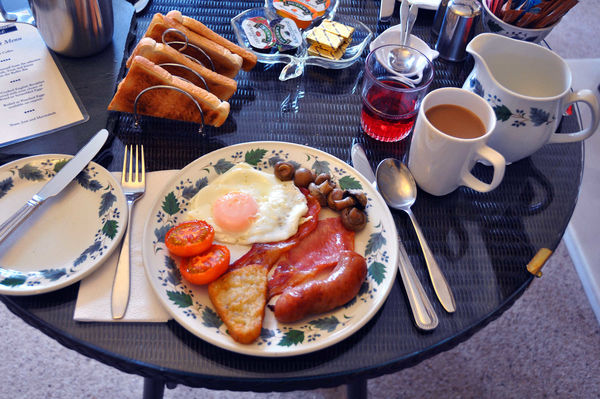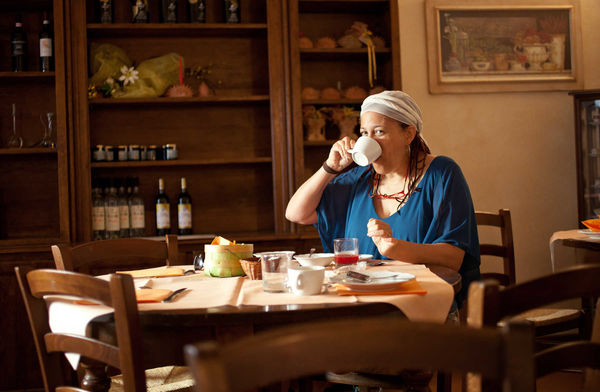Breakfast in Europe


By Rick Steves
One time, I grabbed breakfast at a hotel in southern Spain. The only cereal available was a local version of Frosted Flakes. As there was no "mature" option, I was tickled to have a bowl. But the cereal milk was heated — apparently standard in this part of Spain — and my poor Frosted Flakes immediately turned to mush. Not so grrrrrrreat.
Soggy flakes or not, I find breakfast to be a fun part of my travel day, especially because the experience varies so much from one country's breakfast table to the next.
The farther north you go in Europe, the heartier the breakfasts. The heaviest is the traditional British "fry-up" or "full English" (or Scottish or Welsh) breakfast. This large, home-cooked meal is a fundamental part of the bed-and-breakfast experience, and it's generally included in your room price.
A standard fry-up includes Canadian-style bacon, sausage (and sometimes mackerel or haggis), fried eggs, a broiled tomato, sautéed mushrooms, baked beans, and greasy pan-fried bread or toast. This protein-stuffed meal can tide me over until dinner. You'll quickly figure out which parts of the fry you like. Your host will likely ask you up front which breakfast items you actually like, rather than serve you the whole shebang and risk having to throw out uneaten food. Most British hosts are happy and ready to also supply cereal, porridge, juice, yogurt, and/or fruit, either at a buffet bar or on request.
A Scandinavian breakfast buffet is the perennial favorite for the "most food on the table" award. It pays to take advantage of breakfast smorgasbords when you can (generally included in the cost of your room). Even at about $20, it's a deal by local standards and can serve as your best big meal of the day. This all-you-can-eat extravaganza generally consists of fresh bread, cheeses, yogurt, cereal, fruit, boiled eggs, herring, cold cuts, waffles, and coffee or tea. Grab a drinkable yogurt and go local by pouring it in the bowl and sprinkling your cereal over it. Some hosts provide a roll of foil so you can pack up a lunch from the breakfast spread. If that sounds like a good idea, just ask.
Breakfast is also usually included with your room throughout the Netherlands, Belgium, Germany, Austria, Switzerland, and most points east of there. Though in these areas you can expect a more modest buffet than in Scandinavia, you'll still have plenty of options, including rolls, bread, pastries, cold cuts, cheeses, fruit, yogurt, and cereal. If a buffet has eggs, they're most likely boiled (soft or hard); scrambled or fried eggs are relatively rare.
For breakfast, Germans prefer a sandwich with cold cuts and/or a bowl of Müsli (an oat cereal like granola, but less sweet). Try Birchermüesli, a healthful mix of oats, nuts, yogurt, and fruit that tastes far more delicious than it looks (most commonly available in Switzerland). If breakfast is not included with your room, take a walk to the nearest bakery — every German, Austrian, and Swiss town has at least a few bakeries offering an enticing world of bread and pastry, pulled fresh from the oven that morning.
As you move south and west (France, Italy, Spain, and Portugal), skimpier "continental" breakfasts are the norm. If breakfast is included with your room here, it may be something basic, such as a roll with marmalade or jam, possibly a slice of ham or cheese, and coffee or tea. Many places add items like yogurt, juice, cereal, cold cuts, cheese, fruit, sweet rolls, and eggs to the mix. If your breakfast is too sparse, supplement it with fruit or cheese from a local market.
In many hotels in Spain and France (and some in Italy, Portugal, and elsewhere), you'll have the option of paying extra for breakfast. If that's the case, I often skip the hotel breakfast and visit the corner café, which offers more atmosphere and is less expensive. To save even more, plan ahead to supplement a sparse breakfast by grabbing fruit, yogurt, or cheese from a local market before you head back to your room for the night. Being a juice man, I keep a liter box of OJ in my room for a morning eye-opener. (Juice is generally available at breakfast, but in Mediterranean countries, you have to ask…and you'll probably be charged.)
In Italy, do as the locals do: Stop into a bar or café to drink a cappuccino and munch a cornetto (croissant) while standing at the bar. Italian breakfasts are particularly tiny, but you can buy a delightful toasted sandwich from a corner bar anywhere, anytime in Italy to make up for Italy's particularly minuscule breakfasts. (And I love the delicious red orange juice you get there, which is made from Sicilian blood oranges.) In France, locals often grab a warm croissant and coffee on the way to work. Queue up with the French and consider the yummy options: croissants studded with raisins, packed with crushed almonds, or filled with chocolate or cream. In Spain, start your day at a corner bar or at a colorful café near the town market hall for the desayunos (breakfast special, usually available until noon), which can include coffee, a roll (or sandwich), and juice. Or sample a Spanish specialty, such as churros con chocolate (fritters served with a thick hot chocolate drink), pan con tomate (toasted baguette rubbed with garlic and tomato), or a tortilla española (hearty slice of potato omelet).
If you're a big coffee drinker, note that breakfast is the only cheap time to caffeinate. Some hotels will serve you a bottomless cup of a rich brew only with breakfast. After that, the cups acquire bottoms and refills will cost you. Some Europeans — especially those from big coffee-drinking countries like France and Italy — have specific coffee etiquette.
Sure, in Europe you can find American-style breakfasts of bacon, fried eggs, and orange juice if you look hard enough, but they're nearly always overpriced and disappointing. Instead, come to the European breakfast table with an adventurous spirit. I'm a big-breakfast traditionalist at home, but when I feel the urge for a typical American breakfast in Europe, I beat it to death with a hard roll.

